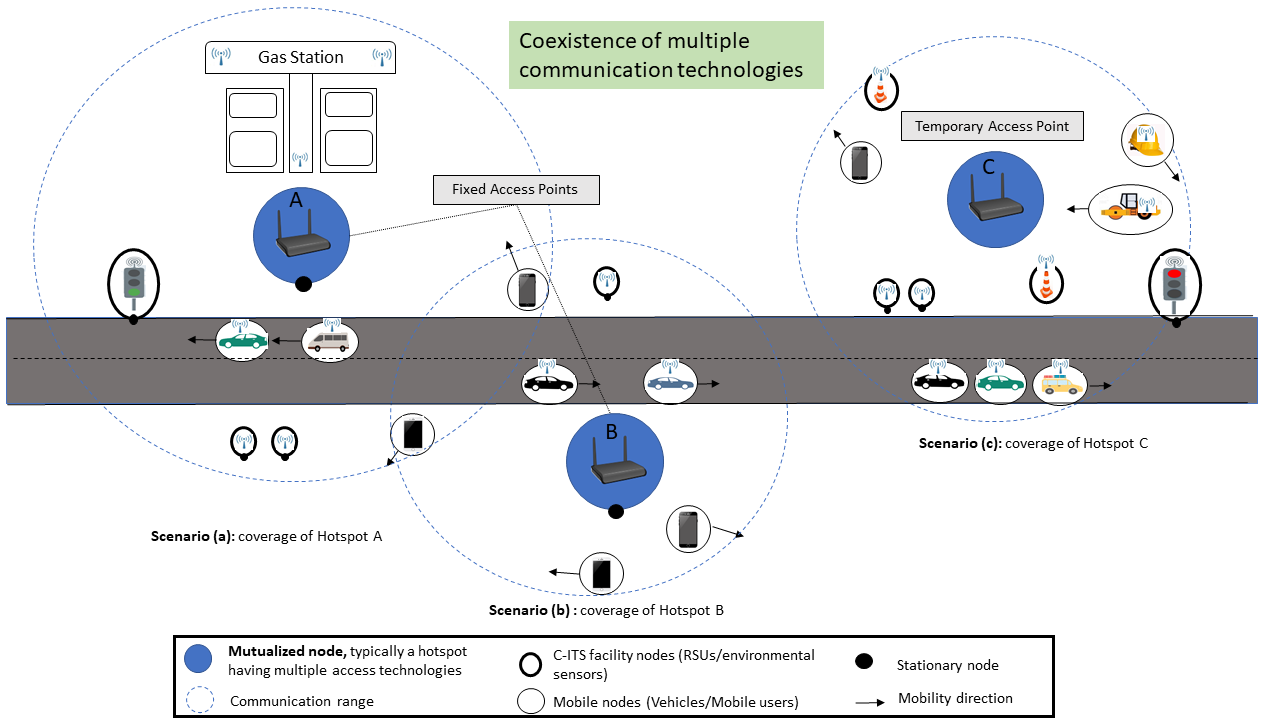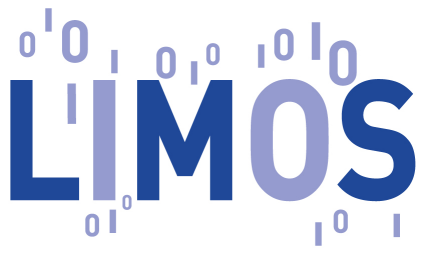Thème Réseau et sécurité
Présentation

Les travaux au sein du thème "réseau et sécurité" concernent principalement les mécanismes de communication sans fil, optimisés et sécurisés.
1 - Les activités autour du “réseau” concernent le transfert des données tout en respectant la qualité de service attendue par les applications. De nombreux types de réseaux sans fil sont étudiés : les réseaux personnels à basse consommation énergétique (IEEE 802.15.4, ZigBee), les réseaux longue portée (LoRaWAN, Sigfox), les réseaux cellulaires, les réseaux Wi-Fi, les réseaux ad hoc, les réseaux mobiles, les réseaux de véhicules (VANET), les réseaux corporels, etc. Les applications ciblées sont généralement des applications de surveillance en environnement contraint (forêts, champs, volcans, mines, aéronefs, smart city, etc.) ou en e-santé. Les contraintes de qualité de service considérées incluent des problématiques de délai, de débit, d'énergie, ainsi que de sécurité (confidentialité, intégrité, authentification). Les contributions concernent principalement la conception, l'analyse, la simulation et l'expérimentation de protocoles réseaux innovants, basés sur la couche d'accès au médium ou la couche réseau. Voici un exemple de quelques sujets étudiés
- Surveillance industrielle : Nous étudions les protocoles MAC/NWK pour les réseaux déployés en milieux confinés et/ou hostiles ayant des besoins importants en termes de qualité de service, principalement le délai et le débit. Les applications visées sont la surveillance de chaînes de production, de centrales nucléaires, de sous-marins, d'aéronefs, etc.
- Surveillance environnementale : Nous étudions les protocoles MAC/NWK pour les réseaux très contraints en énergie et déployés en extérieur, pouvant passer à l'échelle en nombre de nœuds. Les applications visées sont la surveillance de volcans et de montagnes, de forêts, ou de terrains agricoles.
- Réseaux pour l'aide à la personne : Les réseaux sans fil font partie des technologies récentes permettant d’aider les personnes âgées ou à mobilité réduite. Les réseaux sont ici considérés dans leur globalité, de l'intégration du capteur dans un objet du quotidien ou directement sur le patient, à l'expérience de l'utilisateur. Les applications visées sont par exemple l'équipement de fauteuils pour personnes à mobilité réduite, ou encore l'équipement de cannes blanches pour les personnes malvoyantes.
- Réseaux véhiculaires : Nous cherchons à simuler et prototyper des protocoles MAC/NWK pour les réseaux sans-fil mobiles de type VANET, dans des applications de système de transport intelligent collaboratifs.
2 - Les activités en termes de sécurité se structurent autour des problématiques suivantes :
- Sécurité pour la 5G : Nous étudions comment sécuriser les protocoles de communications pour la 5G. Par exemple nous regardons comment établir des clefs de sessions entre des objets connectés. Nous étudions donc la sécurité de protocole comme la messagerie sécurisée SIGNAL, dans le cadre du projet ANR MOBIS5.
- Sécurité des chiffrements symétriques : Dans le projet ANR DECRYPT nous analysons la sécurité des chiffrements symétriques. L’objectif est d’utiliser des méthodes d’IA comme la programmation par contraintes pour cryptanalyser automatiquement ces chiffrements.
- Sécurité des applications : Les protocoles sécurisés se développent avec l’essor d'Internet. Il est crucial d’analyser la sécurité de ces protocoles cryptographiques et de définir les propriétés de sécurité de ces nouveaux cas d’usage. Nous analysons la sécurité des e-examens dans le projet ANR SEVERITAS. Nous regardons aussi la sécurité des protocoles d'e-voting, e-auction…
- Biométrie : L’authentification et l’identification des personnes par les systèmes de reconnaissance biométrique est un sujet traité dans le projet ANR JCJC Privabio. L’objectif est d’étudier la sécurité de ces systèmes et de proposer de nouvelles approches pour améliorer leur sécurité et la protection des données biométriques.
Voici quelques autres exemples d'activité de recherche :
- Nous proposons des protocoles MAC/NWK pour les réseaux sans fil destinés à améliorer les performances de IEEE 802.15.4. Par exemple, nous avons conçu un protocole permettant de gérer deux types de qualité de service : un trafic non contraint, transmis pendant des périodes avec contention, et un trafic prioritaire, qui peut traverser l'ensemble du réseau en un nombre borné de cycles. La gestion de ces deux types de trafic pose des problèmes de dimensionnement des périodes de temps. De plus, lorsque la couche MAC utilise le temps libre d'une période pour transmettre le trafic d'une autre période, des problématiques complexes de routage peuvent se produire, puisqu'un même paquet subit des décisions de routage de deux protocoles de routage distincts. Nous avons donc étudié comment éviter les boucles de routage lorsque le protocole de routage peut changer d'un saut à l'autre, en fonction de décisions de la couche MAC.
- Nous étudions des techniques de décodage de trames en collision dans le protocole longue distance LoRa, afin d'augmenter le débit de ce protocole. Nos techniques se basent sur des informations temporelles venant d'une désynchronisation contrôlée (mais faible) des émetteurs. Les résultats que nous obtenons par simulation et expérimentation montrent que l’on peut décoder un grand nombre de trames en collision.
- Nous avons étudié l'impact des interférences entre Wi-Fi et IEEE 802.15.4. Ces travaux ont permis d'évaluer la baisse de performance d'un réseau IEEE 802.15.4 déployé dans un environnement pollué, typique de déploiements urbains ou dans des usines.
- Nous avons étudié plusieurs problématiques autour des réseaux linéaires, comme l'adressage dynamique des nœuds, ou la réalisation d'une couche MAC permettant de gérer correctement l'augmentation du trafic à mesure que les paquets approchent de la destination (cette augmentation étant liée à l'agrégation du trafic). Les réseaux linéaires apparaissent dans beaucoup d'applications réelles, comme la surveillance de pipelines ou de rivières, ou l'interconnexion de hotspots distants.
- Nous travaillons sur la gestion de la mobilité dans les réseaux sans fil. Nous avons proposé des améliorations au protocole de routage RPL permettant de réagir plus vite aux changements de topologie et à la mobilité des nœuds.
- Nous travaillons sur la prise de contrôle à distance de robots mobiles. Ces robots représentent des méta-capteurs (un nœud mobile équipé de plusieurs capteurs) ayant des contraintes en débit et en latence. Nous étudions une solution avec WiFi en mode ad hoc permettant d'établir des liens fiables et garantissant la QoS pour les applicatifs d’exploitation des robots.
- Nous étudions les communications hybrides au sein des réseaux C-ITS et 5G. Nous souhaitons établir des techniques permettant de faire le choix optimal de technologies de transmission au sein d'un réseau hétérogène accueillant plusieurs technologies comme LTE, Wi-Fi, ITS-G5, ZigBee, etc.
- Nous étudions la sécurité dans les réseaux 5G. Nous nous intéressons à la prise en compte de la capacité limitée des nœuds dans le choix des opérations cryptographiques et dans la façon dont elles vont être exécutées.
- Nous nous intéressons aussi à l'échange authentifié de clés au sein d'un réseau 5G constitué d'objets connectés ayant des capacités de calcul limitées.
- Nous étudions la conception d'algorithmes distribués pour des flottes de robots capables de se déplacer et équipés de lumières de différentes couleurs mais ayant des capacités très limitées (pas de mémoire, pas de moyen de communication, vision limitée, pas de boussole). Le but est de parvenir à explorer un espace discret (en 2 dimensions ou en 3 dimensions) en utilisant un nombre limité de robots et de couleurs.
- Nous concevons des protocoles distribués pour des réseaux dont la topologie change très fréquemment. Le but est de déterminer les hypothèses minimales nécessaires sur le dynamique du réseau (le réseau doit-il rester connexe à tout moment ? la disponibilité des liens de communication doit-elle être périodique ?) tout en garantissant des propriétés de tolérance aux pannes (crashs, corruptions mémoire, perturbations des communications ...)
Nous organisons un séminaire mensuel : https://sancy.iut.uca.fr/~durand/seminaire/
Dernières Publications
Sanitizable Signatures with Different Admissibility Policies for Multiple Sanitizers
Mariem Zayene, Oussama Habachi, Gérard Chalhoub - 18 novembre 2025
Toward hyper-adaptive AI-enabled 6G networks for energy efficiency: techniques, classifications and tradeoffs
Zoé Lagache, Pierre-Henri Thevenon, Maxime Puys, Oum-El-Kheir Aktouf - 12 novembre 2025
Dissecting Mirai : Spatio-Sequential Analysis and Restoration Strategies Using MITRE ATT&CK and D3FEND
30th Nordic Conference on Secure IT Systems (NordSec)
Quentin Bramas, Pascal Lafourcade, Stéphane Devismes - 1 novembre 2025
Infinite grid exploration with synchronous myopic robots without chirality
Discrete Applied Mathematics
Oussama Habachi - 27 octobre 2025
Joint Power Control and User Assignment in RIS-based NOMA: A Multi-kernel Neural Network Approach
MSWIM'25 - 27th International Conference on Modeling, Analysis and Simulation of Wireless and Mobile Systems
Tengfei An, Gewu Bu, Maria Potop-Butucaru, Bilel Zaghdoudi - 22 octobre 2025
Randomness is good enough in DAG-based Federated Learning
Pascal Lafourcade, Elsa Lopez Perez, Charles Olivier-Anclin, Cristina Onete, Clément Papon, Mališa Vučinić - 22 septembre 2025
Fine-grained, privacy-augmenting LI-compliance in the LAKE standard - Extended version
ESORICS 2025 - 30th European Symposium on Research in Computer Security
Lalie Arnoud, Zoé Lagache, Pierre-Henri Thevenon, Aloïs Champenois, Victor Breux, Maxime Puys, Éric Gaussier, Oum-El-Kheir Aktouf - 22 septembre 2025
HENDRICS: A Hardware-in-the-Loop Testbed for Enhanced Intrusion Detection, Response and Recovery of Industrial Control Systems
30th European Symposium on Research in Computer Security (ESORICS 2025), Workshop on Assessment with New methodologies, Unified Benchmarks, and environments, of Intrusion detection and response Systems (ANUBIS)
Florent Durécu, Maxime Puys, Gérard Chalhoub, Paul-Marie Grollemund - 18 septembre 2025
Evaluation of Machine Learning Intrusion Detection Systems Resiliency to Network Traffic Evolution
33rd International Conference on Software, Telecommunications, and Computer Networks (SoftCOM 2025)
Hao Ding, Jing Sun, Rui Long, Xiaoping Jiang, Hongling Shi, Yuting Qin, Zongze Li, Jian-Jin Li - 10 septembre 2025
Visible-Infrared Person Re-Identification Based on Feature Decoupling and Refinement
ACM Transactions on Multimedia Computing, Communications and Applications
Toutes les publis se trouvent ici
Equipe
Responsables
Enseignants-Chercheurs
- ATIGHEHCHI Kevin
- BATTA Mohamed
- BU Gewu
- CHALHOUB Gérard
- DELOBEL François
- DE VAULX Christophe
- DURAND Anaïs
- EL RACHKIDY Nancy
- FREITAS Antonio
- GUITTON Alexandre
- HABACHI Oussama
- LAFOURCADE Pascal
- LI Jian-Jin
- MESNARD Emmanuel
- MIGDAL Denis
- OLIVIER-ANCLIN Charles
- PUYS Maxime
Professeurs émérites
Post-docs
Doctorants
- ADJE Karidja Dominique
- ALLABWANI Osama
- CHAGNON Dorine
- CHEBBI Samar
- DURECU Florent
- MUKUND Shrey
- NAHNAH Oussama
- NAMA NYAM Guy Anthony
- NOUYEP NOUNDJIO Steve Durand
- ZHAO Yan
